Our size and shape
413,567
ongoing, temporary and casual employees
Source: Workforce Profile (2020)
equating to 348,508
full-time equivalent (FTE) employees
Source: Workforce Profile (2020), census period
Source: Workforce Profile (2011–20), census period
Sources: Workforce Profile (2015-20); ABS(2020a)
Structure of the NSW public sector
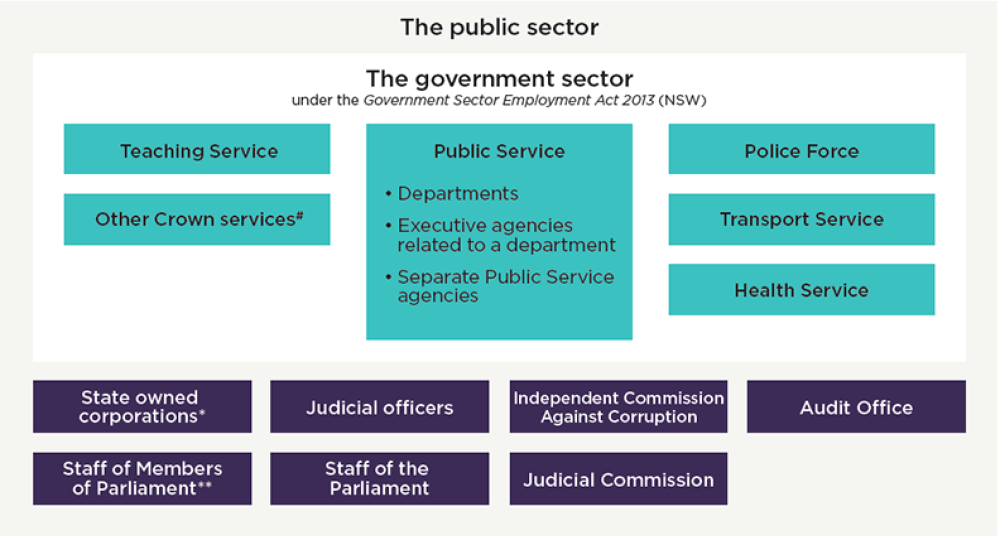
The public sector
- The government sector - under the Government Sector Employment Act 2013 (NSW)
- Public Service
- Departments
- Executive agencies related to a department
- Separate Public Service agencies
- Police Force
- Transport Service
- Health Service
- Teaching Service
- Other Crown services#
- Public Service
- State owned corporations*
- Judicial officers
- Independent Commission Against Corruption
- Audit Office
- Staff of Members of Parliament**
- Staff of the Parliament
- Judicial Commission
# Examples of other Crown services include the TAFE Commission, School Administrative and Support Staff, and Sydney Trains.
* Under the GSE Act, State owned corporations are included in the government sector for certain, specified purposes. In this report, they are treated as part of the public sector but not the government sector.
** The PSC does not collect data on these employees.
Under the GSE Act, NSW universities are part of the government sector for certain, specified purposes. The PSC does not collect data on the employees of NSW universities. They are not considered part of the public sector or government sector in this report.
FTE by cluster
The public sector is structured into nine clusters to coordinate related services.
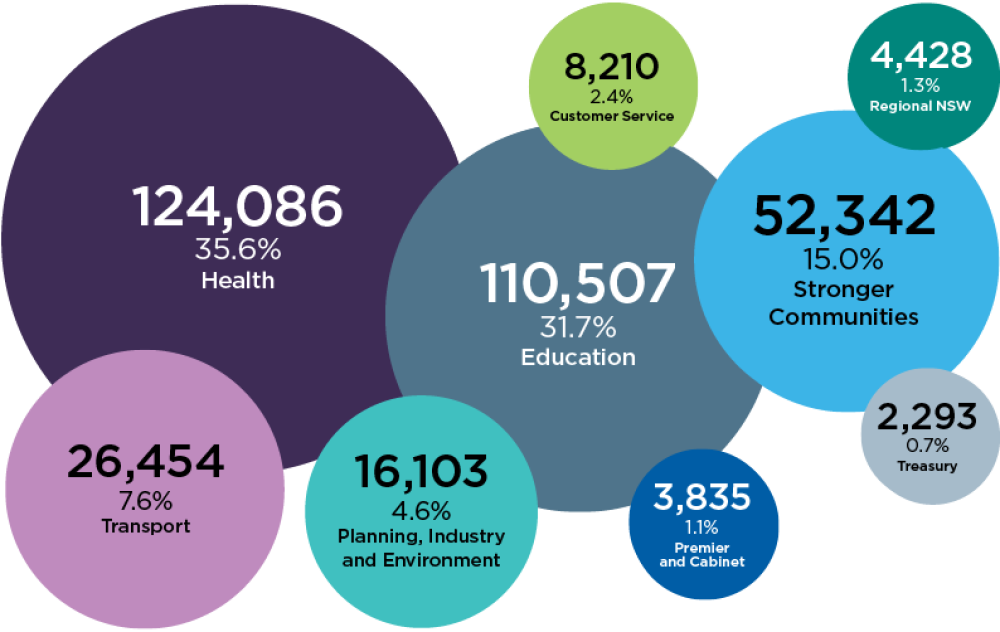
| Cluster | FTE | % |
| Health | 124,086 | 35.6 |
| Education | 110,507 | 31.7 |
| Stronger Communities | 52,342 | 15.0 |
| Transport | 26,454 | 7.6 |
| Planning, Industry and Environment | 16,103 | 4.6 |
| Customer Service | 8,210 | 2.4 |
| Premier and Cabinet | 3,835 | 1.1 |
| Treasury | 2,293 | 0.7 |
| Regional NSW | 4,428 | 1.3 |
Source: Workforce Profile (2020), census period
Note: Percentages indicate the contribution of the cluster FTE to total public sector FTE.
FTE for key occupations, 2020 vs 2019
69,330 School Teachers
up from 66,716 in 2019
49,602 Nurses
up from 48,889 in 2019
16,786 Police Officers
up from 16,586 in 2019
46,227 Clerical and Administrative Workers
up from 44,936 in 2019
24,726 School Support Staff
up from 23,091 in 2019
12,847 Medical Practitioners
up from 12,329 in 2019
7,722 Social and Welfare Professionals
up from 7,531 in 2019
5,268 Cleaners and Laundry Workers
up from 5,091 in 2019
4,352 Labourers
up from 4,266 in 2019
4,649 Ambulance Officers
up from 4,218 in 2019
4,016 Prison Officers
up from 3,848 in 2019
3,987 Firefighters
down from 4,015 in 2019
2,765 Bus Drivers
up from 2,723 in 2019
2,024 Food Preparation Assistants
up from 2,023 in 2019
2,007 Train Drivers
up from 1,937 in 2019
Source: Workforce Profile (2019, 2020), census period
Sources: Workforce Profile (2020); ABS (2020b)
Source: Workforce Profile (2011–20), census period
Note: The ‘Other’ category includes employees whose employment category is Contract Executive, Contract Non-Executive, Statutory Appointee, Transport Senior Manager or Other.
Source: Workforce Profile (2011, 2016, 2020), census period, non-casual only.
Note: To provide a whole-of-sector perspective, remuneration has been aligned with the non-executive grades defined in the Crown Employees (Administrative and Clerical Officers – Salaries) Award 2007. The GSE Act provides for the Premier to determine the bands in which senior executives are employed. There are currently four bands.
3,333 Government sector senior executives in 2020
up from 3,256 in 2019
Source: Workforce Profile (2010, 2020)
Source: Workforce Profile (2014–20)
Headcount and contribution to overall employment by NSW region
Most public sector employees live in Sydney. However, the sector contributes relatively more to overall employment in regional areas of NSW than it does to employment in the city.
Sydney regions
| Region | Headcount | Contribution to employment (%) |
| Sydney East | 135,089 | 9.0 |
| Sydney West | 106,200 | 10.2 |
| Central Coast | 16,656 | 10.7 |
| Newcastle & Lake Macquarie | 23,984 | 13.9 |
| Illawarra | 15,831 | 10.5 |
| Southern Highlands & Shoalhaven | 6,241 | 10.7 |
Greater NSW
| Region | Headcount | Contribution to employment (%) |
| Hunter Valley excl. Newcastle | 11,095 | 8.8 |
| Mid-North Coast | 11,120 | 14.5 |
| New England & North West | 11,280 | 13.1 |
| Far West & Orana | 10,596 | 20.5 |
| Coffs Harbour–Grafton | 8,574 | 16.9 |
| Richmond–Tweed | 12,858 | 11.6 |
| Capital Region | 11,152 | 9.4 |
| Riverina | 10,058 | 12.7 |
| Murray | 5,820 | 10.0 |
| Central West | 14,723 | 13.2 |
Sources: Workforce Profile (2020); ABS (2020a)
Our people
Median agency tenure, 2020 vs 2019
8.4 years in 2020
8.5 years in 2019
Source: Workforce Profile (2019, 2020), non-casual only
Sources: Workforce Profile (2020), non-casual only; ABS (2016a, 2019a)
Sources: Workforce Profile (2020); ABS (2020c, 2020d)
Sources: Workforce Profile (2020), non-casual only; ABS (2015a, 2016b)
Sources: Workforce Profile (2020) non-casual only; ABS (2016c, 2016d)
Sources: Workforce Profile (2020), non-casual only; ABS (2018a, 2018b)
Source: People Matter Employee Survey (2020)
Notes: All diversity statistics are based on self-disclosed information. Throughout this report, ‘Aboriginal peoples’ is used to refer to all Aboriginal and Torres Strait Islander peoples. The government sector is a subset of the public sector. LGBTIQA+ representation is based on the People Matter survey, which had a response rate of 47.3% in 2020.
Source: Workforce Profile (2011–20), non-casual only
Source: Workforce Profile (2016, 2020), non-casual only
Source: Workforce Profile (2020), non-casual only
Progress on the Premier’s Priority to drive diversity in the government sector
Women in senior leadership
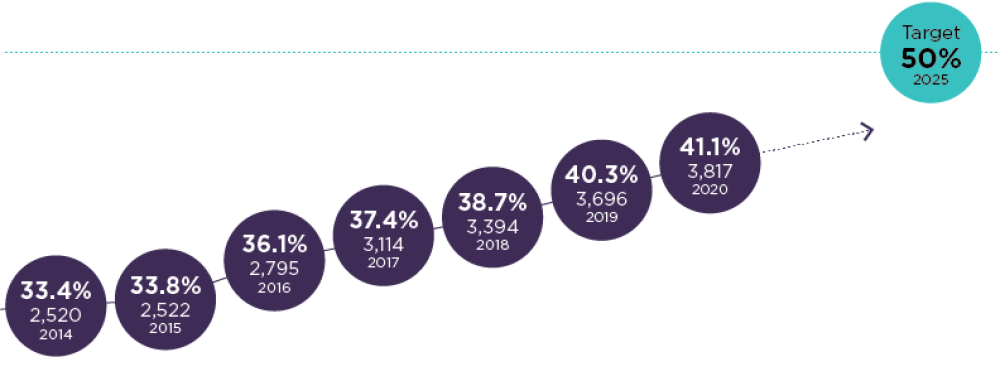
| 2014 | 2015 | 2016 | 2017 | 2018 | 2019 | 2020 |
| 33.4% | 33.8% | 36.1% | 37.4% | 38.7% | 40.3% | 41.1% |
| 2,520 | 2,522 | 2,795 | 3,114 | 3,394 | 3,696 | 3,817 |
Target: 50% by 2025
Aboriginal people in senior leadership
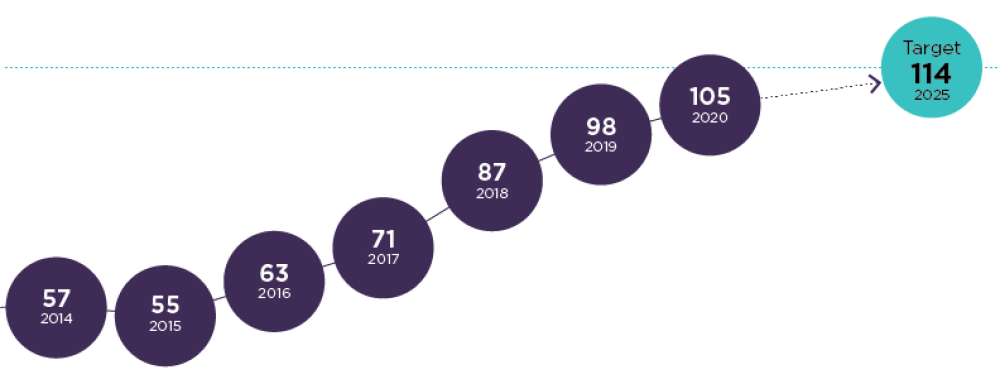
| 2014 | 2015 | 2016 | 2017 | 2018 | 2019 | 2020 |
| 57 | 55 | 63 | 71 | 87 | 98 | 105 |
Target: 114 by 2025
People with disability
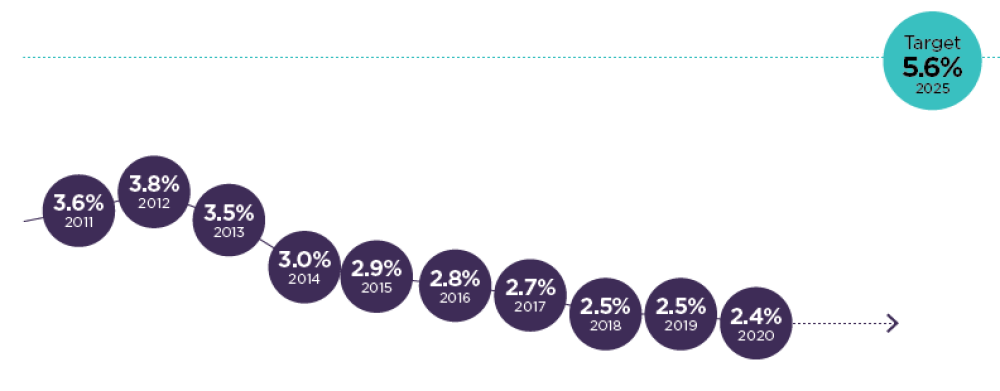
| 2011 | 2012 | 2013 | 2014 | 2015 | 2016 | 2017 | 2018 | 2019 | 2020 |
| 3.6% | 3.8% | 3.5% | 3.0% | 2.9% | 2.8% | 2.7% | 2.5% | 2.5% | 2.4% |
Target: 5.6% by 2025
Source: Workforce Profile (2014–20), non-casual only.
Note: Senior leaders are non-casual government sector employees with a salary equal to or higher than $165,750 in 2020, excluding Health roles of a specialist or technical nature with no leadership or managerial responsibilities, and Justice roles with a statutory or institutional character (such as judges, magistrates and barristers).
Our performance
Customer satisfaction for consumers and businesses, 2020 vs 2019
82.0 for consumers
up from 80.6 in 2019
80.7 for business in 2020
up from 77.6 in 2019
Source: Customer Satisfaction Measurement Survey (2019, 2020)
Government sector net worth
$238 billion
Source: NSW Treasury Budget Statement 2020–21 (2020)
Government sector employee-related expenses as a percentage of general NSW Government expenditure, 2020 vs 2019
Government sector employee-related expenses as a percentage of general NSW Government expenditure dipped between 2019 and 2020. This was partly due to increased government spending to speed up recovery in NSW in the face of the COVID-19 pandemic.
45.0% in 2020
46.5% in 2019
Sources: NSW Treasury Budget Statement 2019–20 (2019); NSW Treasury Budget Statement 2020–2021 (2020)
Median salary, 2020 vs 2019
$90,123 in 2020
$87,926 in 2019
a $2,197 or 2.5% increase
Source: Workforce Profile (2019, 2020)
Note: The increase in median salary reflects the pay increase that came into effect on 1 July 2019.
Source: Workforce Profile (2010–20)
Median salary by gender
$92,176
for men
$90,123
for women
Source: Workforce Profile (2020)
Note: Employee salary means the full-time base renumeration for the role, regardless of whether the employee is working part time or full time.
Gender pay gap, 2020 vs 2019
$2,053
Up from $2,002 in 2019
Source: Workforce Profile (2019, 2020)
Note: Employee salary means the full-time base remuneration of the role, regardless of whether the employee is working part time or full time.
People Matter survey response rate, 2020 vs 2019
47.3% in 2020
52.8% in 2019
Source: People Matter Employee Survey (2019, 2020)
Employee engagement, 2020 vs 2019
67.2 in 2020
65.7 in 2019
Source: People Matter Employee Survey (2019, 2020)
Rates of self-reported experienced and witnessed bullying, 2020 vs 2019
13.9% experienced bullying in 2020
down from 17.9% in 2019
21.7% witnessed bullying in 2020
down from 32.9% in 2019
Source: People Matter Employee Survey (2019, 2020)
Employees with a performance plan, and who have informal and scheduled feedback conversations, 2020 vs 2019
Employees with a performance plan
72.3% in 2020
Up from 71.5% in 2019
Employees who have informal feedback conversations
79.2% in 2020
Up from 76.3% in 2019
Employees who have scheduled feedback conversations
63.3% in 2020
Up from 59.5% in 2019
Source: People Matter Employee Survey (2019, 2020)
Hours of paid unscheduled absence per FTE, 2016–20
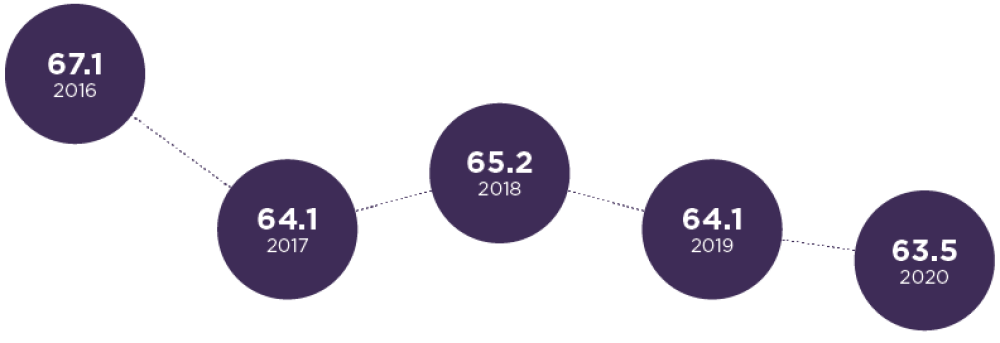
| 2016 | 2017 | 2018 | 2019 | 2020 |
| 67.1 | 64.1 | 65.2 | 64.1 | 63.5 |
Source: Workforce Profile (2016–20), annual reference period
Employees working flexibly and satisfied with their flexible work arrangements, 2020 vs 2019
Employees working flexibly
78.4%
Up from 62.5% in 2019
Employees satisfied with their flexible work arrangements
65.5%
Up from 58.9% in 2019
Source: People Matter Employee Survey (2019, 2020)